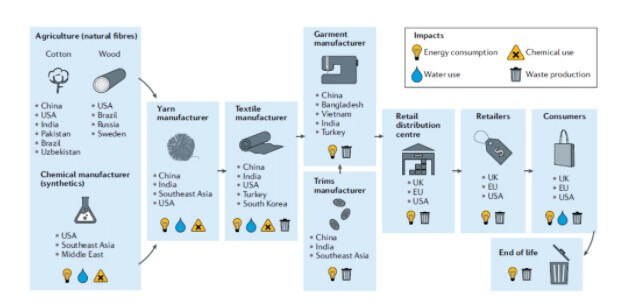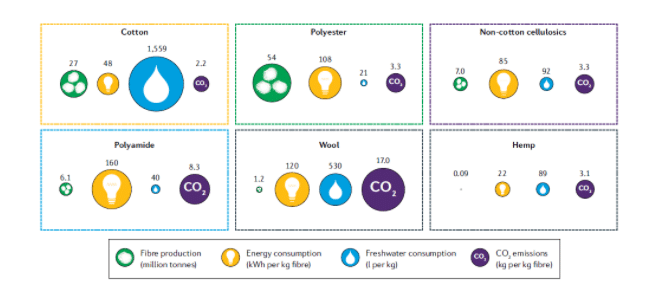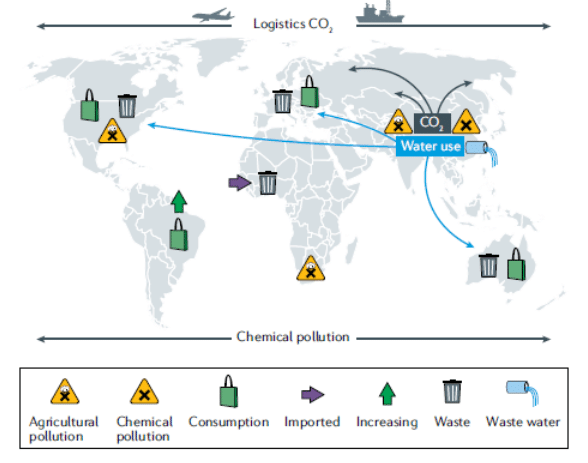Fast fashion involves the quick design, production, and distribution of affordable replications of Fashion weeks’ outfits as collections are released. Fast-fashion outfits are characterized by being low quality and having a short product life, leading to unsustainable consumption[2].
On average, 60% more clothes were sold in 2014 than in 2000, a fact that was seized by fashion companies to step up their offer from two collections per year in 2000 to five in 2011. Consequently, the environmental impact of the fashion industry keeps growing as we keep purchasing more clothes.
Water resources are especially affected as the market grows, and the effects are expected to escalate if the industry does not go through a change in water management practices.
Water pollution and exhaustion are most notable in those areas where raw materials are produced and textiles are processed, yet the environmental impact goes beyond pure materials transformation and textiles production. Trucking and transport also adds-up to the industry’s negative impact, turning the fashion industry into the second most polluting sector[3].
The fashion industry consumes around 79 trillion litres of water per year[2], equivalent to 263 times the daily volume flow of the Nile River. Additionally, the business is responsible for approximately 20% of industrial water pollution, derived from processes like textile treatment, and dyeing, while at the same time contributing to 35% of primary microplastic pollution in our oceans[2].
Around 60% of the production of the global fibres is destined for the fashion industry, out of which 51% accounts for polyester, followed by cotton with 25%, as shown in Figure 1.

The mentioned facts ring a bell to become more conscious of our clothes consumption. Fast fashion is what it is today because, we, as consumers keep purchasing cheap items without realizing their environmental consequences, particularly in our water resources. Add to that the large share of produced clothing that end-up wasted in landfills.
Each block of the fashion supply chain has different effects on the environment, from water and chemical use during fibre, yarn, and textile production. A scheme of the clothing supply chain is shown in Figure 2.

From the beginning of the production chain down to the consumer phase, the fashion industry needs to be reconceived by introducing sustainability concepts along with the whole clothes’ lifespan. From a manufacturing perspective, the implementation of more eco-friendly practices, like wastewater treatment and reuse, accompanied by the introduction of more sustainable dyes, are methods that will lessen the negative effects on the environment.
Wastewater reuse in the fashion industry poses the challenge of demanding different qualities for every fibre. Therefore, coupling efficient fabric sorting and separation techniques with wastewater treatment techniques for recycling are crucial for achieving a cleaner industry.
Most of the associated water use for fashion purposes derive from cotton cultivation and the wet processes in textile manufacturing. From the 6 fibres shown in Figure 3, the material used to make 40% of our clothing[3] is the most water-intensive crop.

Current global water use in irrigation for cotton production reaches up to 44 trillion litres per year[2], equivalent to 147 times of the daily volume flow of the Nile river. These numbers represent a challenge for countries already under water stress conditions, where most of the cotton for textiles is produced, such as India, China, and Uzbekistan.
At this point, one might think that purchasing items made with organic cotton could solve the problem, yet there are opposed opinions on the topic. In essence, organic cotton requires more water than conventional cotton, as shown in Figure 3.

The case of Uzbekistan rings a bell with regards to the Aral Sea disappearance, now called the Aralkum desert. It has been determined that 20% of the water loss suffered by the Aral Sea was driven by cotton consumption in the EU[2].
With this situation in mind, the adoption of water-efficient irrigation practices and better cultivation technology in cotton fields gain relevance. Augmenting water productivity in cotton growth would still guarantee a high yield while utilizing water sources more sustainably.
The case of the Aral Sea is a reflection of how foreign demand for cheap clothes is responsible for a high water impact far from where the garments are purchased, as shown in Figure 4.

Figure 4 shows the need for us as consumers to shift our mentality towards more mindful clothes purchasing. Supporting local independent brands that base their business on sustainable practices, such as textiles recycling, and supervise the use of non-toxic, sustainable chemistry in the supply chain could lead to a change in the industry.
Also, donating our no-longer wanted clothes instead of throwing them away would drive forward the adoption of a local circular model in the clothing industry. Additionally, supporting initiatives that promote peer-to-peer clothes sharing, based on a shared economy model aids in the minimization of the industry’s environmental impact.
Water Experts promotes the reuse and sustainable management of water resources in every industry by addressing the sector’s requirements and environmental targets. This way we ensure a more sustainable industry operation without compromising our freshwater assets.
[1] Nishat, ‘How is fast fashion polluting our water?’, Open Access Government, Nov. 14, 2019. https://www.openaccessgovernment.org/how-is-fast-fashion-polluting-our-water/77704/ (accessed Aug. 05, 2020).
[2] K. Niinimäki, G. Peters, H. Dahlbo, P. Perry, T. Rissanen, and A. Gwilt, ‘The environmental price of fast fashion’, Nat. Rev. Earth Environ., vol. 1, no. 4, Art. no. 4, Apr. 2020, doi: 10.1038/s43017-020-0039-9.
[3] A. Brenot et al., ‘6 - Water footprint in fashion and luxury industry☆’, in Water in Textiles and Fashion, S. S. Muthu, Ed. Woodhead Publishing, 2019, pp. 95–113.
[4] M. Bain, ‘Your organic cotton t-shirt might be worse for the environment than regular cotton’, Quartz. https://qz.com/990178/your-organic-cotton-t-shirt-might-be-worse-for-the-environment-than-regular-cotton/ (accessed Jul. 28, 2020).